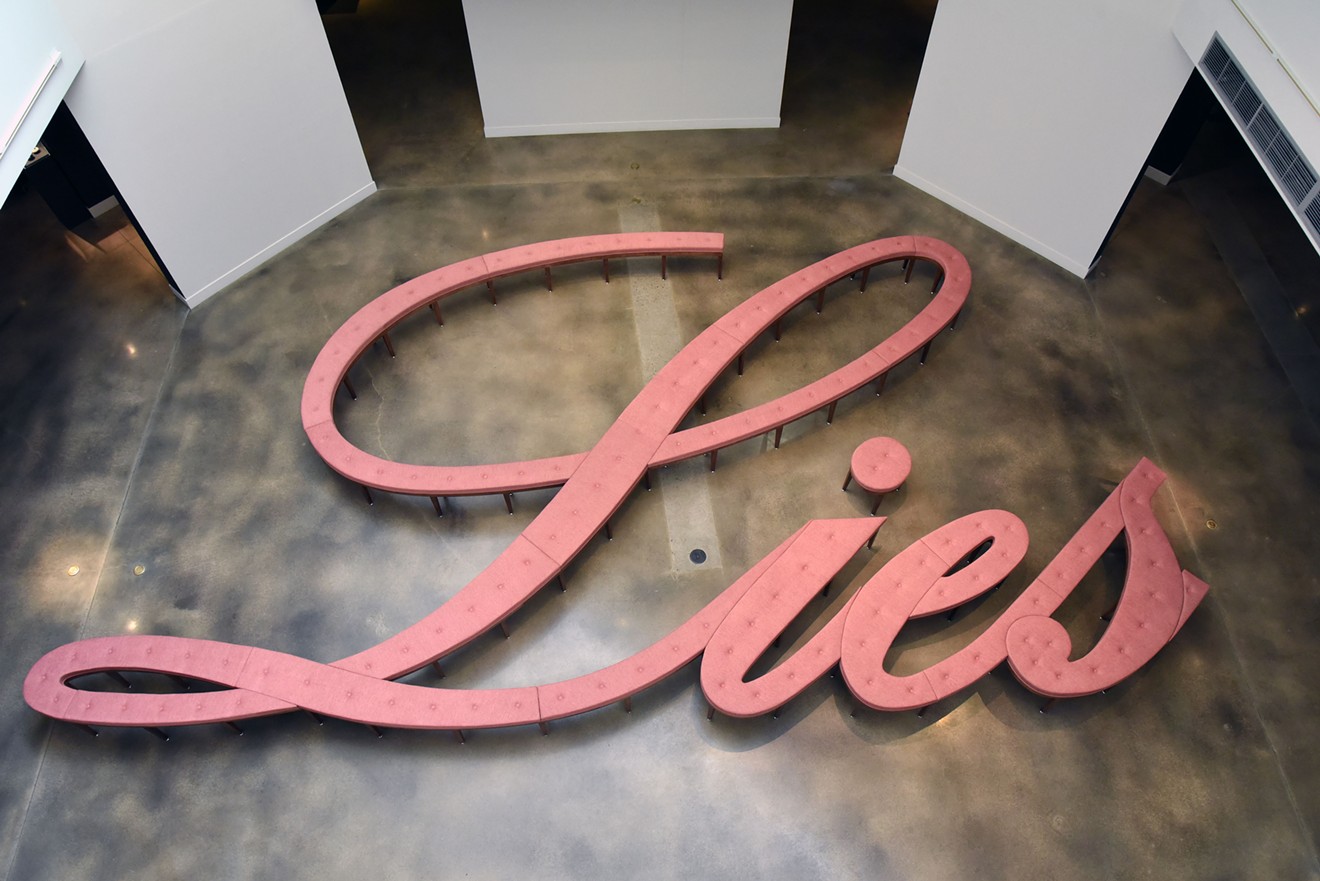
"Lies Bench," by Michael Beitz, seen from above at Blurring the Line.
Wes Magyar, courtesy the Arvada Center
According to Collin Parson, who co-curated the show with Kristin Bueb, many people have assumed that Blurring the Line is a response to Serious Play, but that’s not the case: He and Bueb didn’t even know about the DAM show when they planned the Arvada exhibit. Parson also told me that neither he nor Bueb knew anything about this field before diving into it; although almost everything in their show is associated with contemporary art, nearly all of the works fall outside their typical bailiwicks of painting and sculpture.
Blurring the Line is divided into three sections: The objects in the main galleries on the ground floor all refer in some way to residential designs, the upper-level galleries hold wearable art, and jewelry is the focus in the theater gallery. The principal conceit of the entire endeavor, displaying things that are pointedly unusable despite their references to utilitarian objects, is conveyed in the entryway, where Michael Beitz’s “Table” is installed. Conceptually, it's based on a traditional library table, but it can’t possibly be used as one because the top takes the form of a circular arch with virtually no horizontal area on which to read or write. With a couple of actual chairs tucked in at either end, it’s reminiscent of a keyhole gate, heralding the outrageous takes on the familiar in store for the viewer.
Beitz is also responsible for Blurring the Line’s tour-de-force moment, the installation “Lies Bench,” a suite of dark-stained maple benches upholstered in salmon chenille that together spell out the word “Lies” in a loopy cursive reminiscent of advertising script. The benches themselves are chic-ly proportioned, bringing to mind the less-is-more aesthetic of designer Edward Wormley. Taking over the atrium’s floor and transforming it into a glitzy lobby, “Lies Bench” is especially impressive from the overlook on the second floor.

Installation view of Blurring the Line, with Phillip Mann's "Relic Chair" in the foreground.
Wes Magyar, courtesy the Arvada Cener
Some pieces could be used as intended, in particular the lighting, such as the marvelous and imaginative “Moto Floor Lamp” by Kelton Osborn, a colorful assemblage of elements in powder-coated steel and bent plywood that uses found motorcycle headlights for illumination. Even more useful is “Light Obelus I,” by Mathias Leppitsch, whose concrete shade sits on a simple thin wire construction and has a retro mid-century vibe.
Among the few things that are straightforwardly functional are the richly decorated cabinets by Anne Bossert. Using dyes and inlays, Bossert focuses on the surfaces of these handsomely scaled pieces that broadly recall the work of Gio Ponti. While some of the ceramics are functional, many are not, including the nested loops of porcelain in stoneware bowls by Alleghany Meadows, the grid of mugs in a wooden wall shelf by Camila Friedman-Gerlicz, and the triangular volumes hung in an interlocking grid, some with flowers in them, by Emily Stevens.
At the opposite end of the scale are the weird constructions and accumulations by Donald Fodness, a fixture of Denver's contemporary installation and sculpture scene. His “Multi-Tool Chiminea” is the most outrageous thing in Blurring the Line, and even crosses it. A chiminea is a freestanding fireplace, and Fodness has attached many things to this one, including a flag and a line hung with clothing hooked to the wall.
The pieces in the upper-level galleries are oddball takes on fashion, with several adding a frisson of danger. Woe be to those who run into the woman wearing the tutu of metal rods that makes up “Farthingale,” or try to speak with one wearing “Elizabethan Collar #5,” made of jutting brass rods, both by Jesse Mathes. Nearby is a pair of exquisitely made harnesses in mixed metals by Ira Sherman, the dean of hostile yet wearable art around these parts. One piece is to be worn by a man, the other by a woman; collectively, they're “The Chaperone.” The two armored corsets are used in a performance recorded on video that plays on a monitor on the wall. In it, models wearing the stainless-steel and brass vests are suspended from the ceiling by moving cables, and as they come toward one another to the point of touching, a hidden feature sends them flying apart.
Far less dangerous are the high-tech ideas encompassed in the pieces by Kristin Stransky, including a dress made of hundreds of tiny 3-D printed snaps pushed together to freely suggest a garment. Also interesting are her dresses and jackets, with electronic components like LEDs that light up and change.
The display in the intimate theater gallery is both the smallest and the least outlandish of the three sections. That may be because jewelry is smaller than cabinets or dresses, or it could be because jewelry already has such a wide latitude. Still, there are some pretty unusual things, like Ryan Gardner's “Corvetteite," with its dried overspray of layered colors from the GM paint shop where the Corvette was made that’s been cut and polished. The twigs and vines in metal by Pamela Webb are simultaneously theatrical and naturalistic.
Though a handful of artists and artisans in Blurring the Line are well known in Denver — Osborn, Fodness, Sherman — most will be unfamiliar to the contemporary-exhibition audience, even though they're all Colorado artists. That alone makes the show worthwhile — but there's also the bonus of that unforgettable “Lies Bench.”
Blurring the Line, through August 25 at the Arvada Center for the Arts and Humanities, 6901 Wadsworth Boulevard, Arvada, 720-898-7200, arvadacenter.org.














